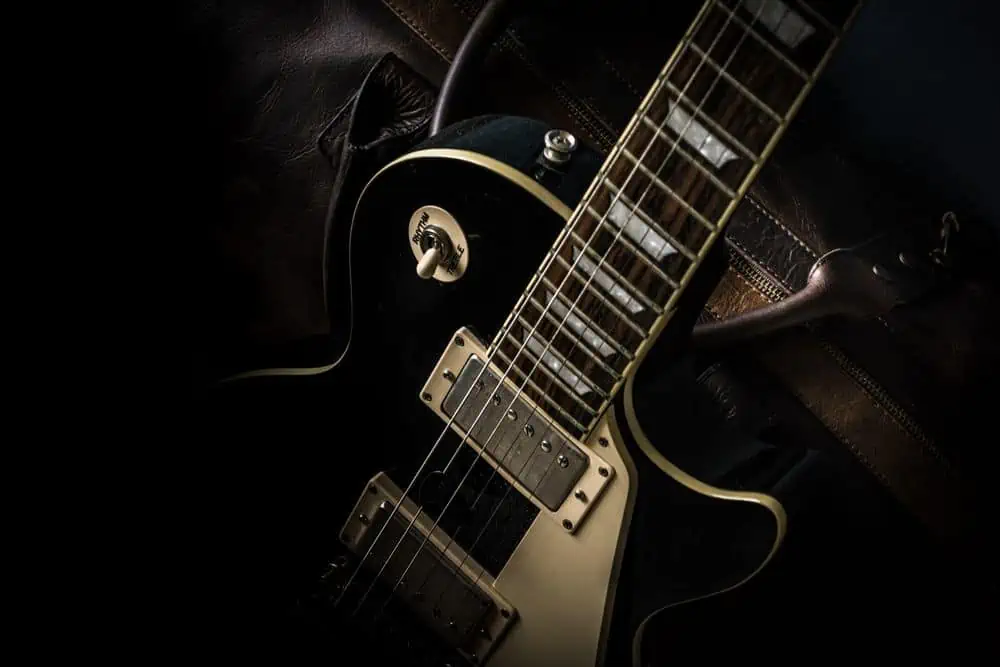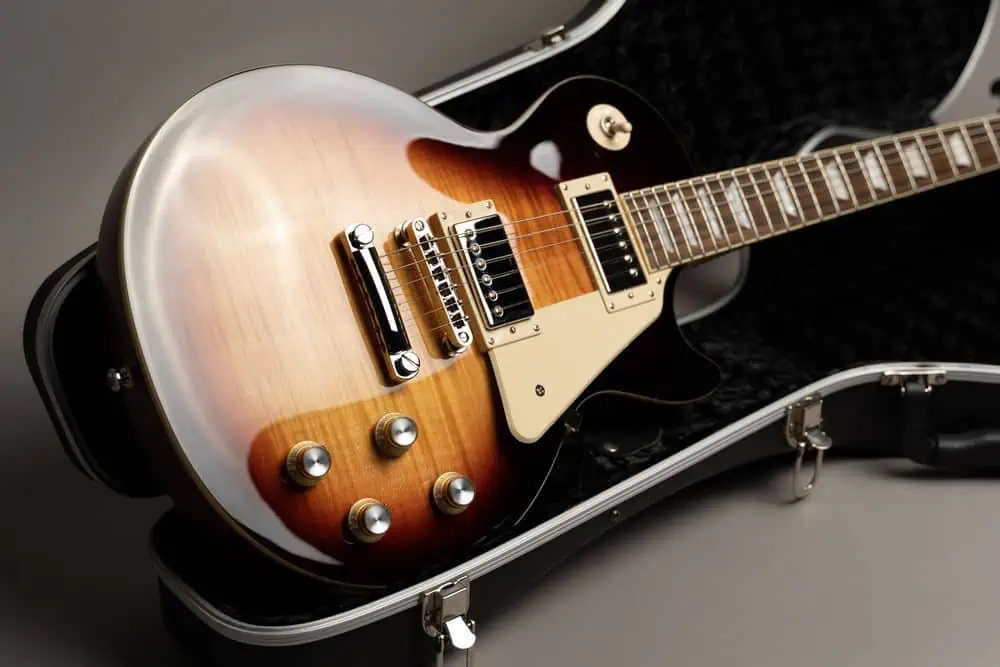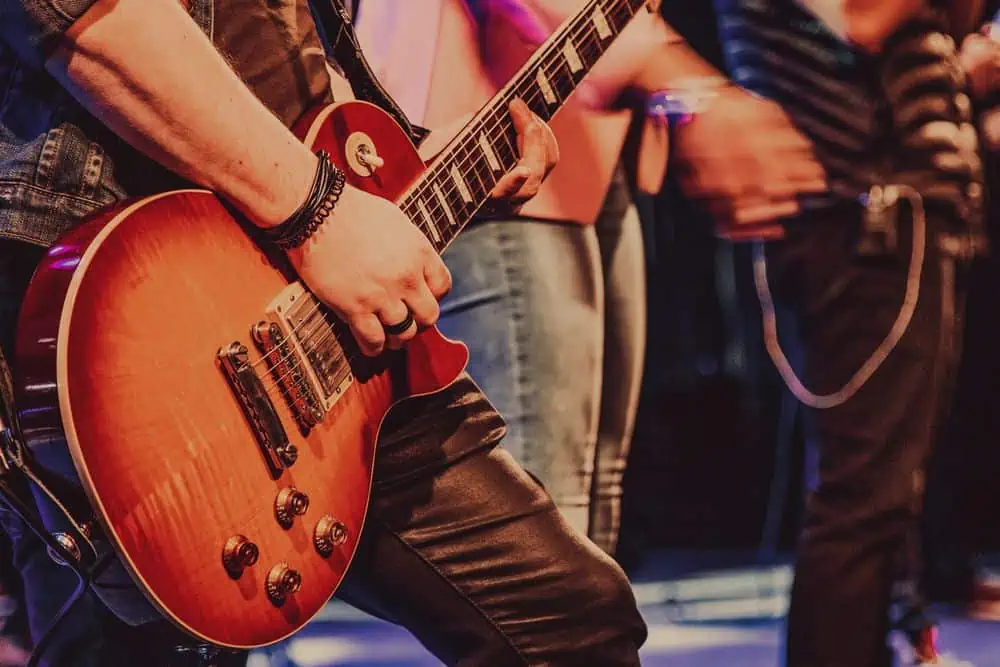 The Gibson Les Paul is one of the most sought-after guitars in history.
The Gibson Les Paul is one of the most sought-after guitars in history.
It might even be number one.
But not all of them.
There is a big difference in quality between different periods in the company’s history.
Some years, Gibson gifted the world with some of the best guitars ever made. Other years, they churned out crap.
So which are the Gibson Les Paul years to avoid? And which are the ones you want?
Keep reading to find out when Gibson made good guitars and when they made bad ones. You don’t want to get stuck with one of their duds.
Table of Contents
Gibson Les Paul Years To Avoid And Why
The Gibson Les Paul years you want to avoid the most run from 1968 to 1985. Those are the absolute worst years. The second bad period ran from 2007 to 2012.
Of course, there were some good guitars in those years, but the majority of the Les Pauls released in those two periods were pretty bad.
Gibson has had many ups and downs over the years. After the golden era of the 50s and 60s came the era from 1969 to 1985 in which the quality decreased considerably.
In 1986, things began to pick up, and a new golden era appeared between 2001 and 2005. But the good times did not last.
In 2010, the factory was flooded. In 2011, their rosewood was confiscated and they had to go out and use something else.
Following these debacles, Gibson undertook a process of “rebuilding their quality and reputation.” That led them to 2013, when they began producing some of the best Gibson guitars in decades.
The 1950s: The Golden Era Of Gibson
The original 50’s Les Paul was a solid one-piece mahogany guitar, with a one-piece mahogany neck, a rosewood fretboard, a maple top, and two P90 (’52-’56) or two PAF (’57-’60) humbuckers.
Unfortunately, it was discontinued in 1961. But luckily, it was reissued in 1968, although with P90s, which had a mixed reception among guitar enthusiasts.
The late 50s were considered the golden era of the Les Paul guitar, with 1959 being the most prominent year of them all.
The 1959 models are currently breaking the records of the most expensive guitars ever sold. And with good reason – they are simply perfect.
The 1960s: The Quality Continues
Following the 1959 success, Les Pauls made in 1960 were incredibly popular as well. They retained almost the same quality level. From 1961 to 1968 nothing notable happened, but the following three years saw amazing Customs and Deluxe models.
While not as popular as some Gibson Les Pauls, these are of fantastic quality. In 1969, the neck became three-part mahogany and mini humbuckers appeared, replacing the P90s.
1970 To 1985: An Era Of Disaster
The start of a new decade (1970) also saw the beginning of the worst era for the Gibson Les Paul guitar. This disaster era lasted for approximately 15 years!
Of course, not every single Gibson Les Paul guitar manufactured during this period is terrible. Some individual pieces are rather good.
But in general, these are the years to forget for the famous guitar manufacturer. They experimented to cut costs, which led to quality dropping drastically. These were the most notable years.
- In 1973, they replaced the laminated mahogany neck with another three-part maple laminate, with a rosewood fingerboard.
- From 1974, they began making the body in two sandwich-type pieces (pancake). Humbuckers appeared again but they were only available on the Custom.
- In 1977, the body was once again one-piece mahogany with a maple top, while the neck was still 3-piece laminated maple.
- In 1982, they began to lighten the body by means of 9 internal holes, called “Weight Relief”. They continued to use this method continuously until 2012.
- In 1984, the mahogany neck returned in one piece.
1986 To 2006: The Modern Golden Era
After those “dreadful” 15 years came the 90s, with some fantastic guitars. The improvement actually started in 1986 but it was the 90s when the good times really kicked off.
During the “modern golden era”, Les Pauls from 1990 to 1996 received amazing feedback. The next 10 years went by quietly with more or less the same success (much like what the 60s were to the 50s).
The period from 2001 to 2005 repeated the highest Les Paul quality. The last notable moment happened in 2006 when the “chambering”, or total hollowing out of the instrument, appeared in some models. From there came unrest.
2007 To 2012: The Second Worst Era
The great quality of the previous era could not be replicated in these years, due to a lack of good materials.
- In 2008, the Les Paul Standard received a total “facelift” – chambering, compound radius neck, PLEK system, and locking tuners.
- In 2009, faced with the public’s rejection of the changes to the Standard model, Gibson decided to “relaunch” the “traditional” Les Paul Standard, but without discontinuing the renewed model. “The Traditional” is born. The Traditional has a 9-hole lightened, mahogany body in one or two parts, mahogany neck, and rosewood fretboard.
- In 2010, the Nashville factory was completely flooded and all the stock of wood and machinery was lost. Gibson had to resort to alternative woods and the quality went down.
- In 2011, the US government confiscated all the Rosewood and ebony stock that Gibson had just acquired due to fraudulent importation. So they had to replace the rosewood with alternative woods, and even with Richlite, a synthetic material that replaced ebony on Customs. Gibson was forced to purchase rosewood that is thinner than necessary, and lamination was necessary to achieve the correct thickness.
- 2012 was a year of transition in which Gibson tried to recover from the tremendous losses by producing mass-selling economic models.
2013 To Present Times: Back To The Roots
Finally, we come to 2013, when Gibson decided to recover its prestige by launching the best Les Paul in decades – the Traditional 2013.
It has a one-piece mahogany neck with a solid rosewood fretboard, with an R8 profile (thicker than the 50s). The body, for the first time since 1982 in a Les Paul Standard/Traditional, is solid Mahogany without any holes or chambering.
The tuners are exact replicas of the original ones from the 50s. Build quality, materials, paint, and hardware are the best quality ever used on a production of the Les Paul.
The 2013 Standard/Traditional combination of features hadn’t been found on a Les Paul since 1960.
Gibson finally raised quality again, to the best level in its history. In the modern era, the 2013 Standard and Traditionals are recognized as some of the best Les Pauls ever built.
They only differ from the originals, in broad strokes, by using the modern Short Tenon instead of the old Long Tenon and a Nashville bridge instead of ABR1.
But that’s what the Custom Shops are for, which strictly respect even the smallest detail.
Yes, Gibson is back to building top-notch Les Pauls. However, there are some Les Paul models from the 2014 to 2015 period with questionable quality.
Worst Gibson Les Paul Years: Final Thoughts
When buying a Gibson Les Paul, you should avoid the years from 1969 to 1985 and from 2007 to 2012. While not all guitars from these years are bad, most are.
For that reason, most people avoid those years and we suggest you do the same. Save yourself the potential disappointment.
Of course, not all guitars made during the good years are good. There are still some duds out there from the good eras, too. Always inspect any potential purchase thoroughly, even if it is from the very best year in the company’s history.
And if you want a Les Paul, but it just isn’t in your budget, there are some great alternatives out there that cost quite a bit less. Check out this article on the best Gibson Les Paul copies selling for less than $1000.




The worst Les Pauls made were in 1959. Don’t even think of buying one. I will buy it, so you don’t have to, just so I can report on how bad it is. I will be back soon with my report. Don’t go anywhere.
Sadly, this misinformation appears on one of the top Google searches. What bs. I have played Norlins that were out of this world. Ron hit the nail on the head in the post above, Gibson made excellent guitars and dud guitars every year of their existence.
Everyone is starting to figure this out and the prices of Norlins are going up. I wish more people were buying into this crap and you could sill get them for cheap. haha.
Had a ’76 Custom (wine), bought from GC in Hollywood, CA. Loved it…beat the shit out of it playing clubs 6 nights a week for years…3 fret jobs and 6 cases before I finally gave it to a friend. Did have some neck issues – some delamination of the 3 pieces, steamed and re-glued by a reputable luthier. Over time, I began to feel the seams again & tuning became an issue. Still the best sounding guitar I ever owned.
Hi the info you gave is incorrect ( From 1974, they began making the body in two sandwich-type pieces (pancake). Humbuckers appeared again but they were only available on the Custom. )
I have 2 1974 Gibson Les Paul Standards with Humbuckers they were the first reissue Les Paul with the Humbucker pickups here are some 1974 Les Paul standards in the link with Humbuckers!
https://reverb.com/uk/item/27844634-gibson-les-paul-standard-1974-tobacco-sunburst
kind Regards
John Conroy
I bought a 2023 60s version Les Paul it’s great and resonates wonderful unplugged when plugged in it sounds magnificent I got a lucky one going to keep it forever
The most hilarious part of all this is that it’s the same every year at Gibson and has been this way since the beginning. You ready for this?
NO MATTER WHAT YEAR IT IS, GIBSON MADE DUDS THAT YEAR AND THEY MADE GREAT EXAMPLES. Doesn’t matter if we’re talking 1956, 1971, 1999, 2008, or 2023. It’s the same EVERY year. Some are duds and some are absolutely outstanding.
The fact that you keep perpetuating this nonsense that “these years suck so don’t buy those” just shows how uninformed or narrow-minded you really are.
I have a 2007 Double cut and it’s awesome. When you buy a guitar you can tell by holding it if it’s junk.
What a bunch of ill-informed nonsense.
You go ahead and avoid those. Some of the greatest albums in music history were played on Gibsons from 1968 to 2005. That just leaves more for us to choose from.